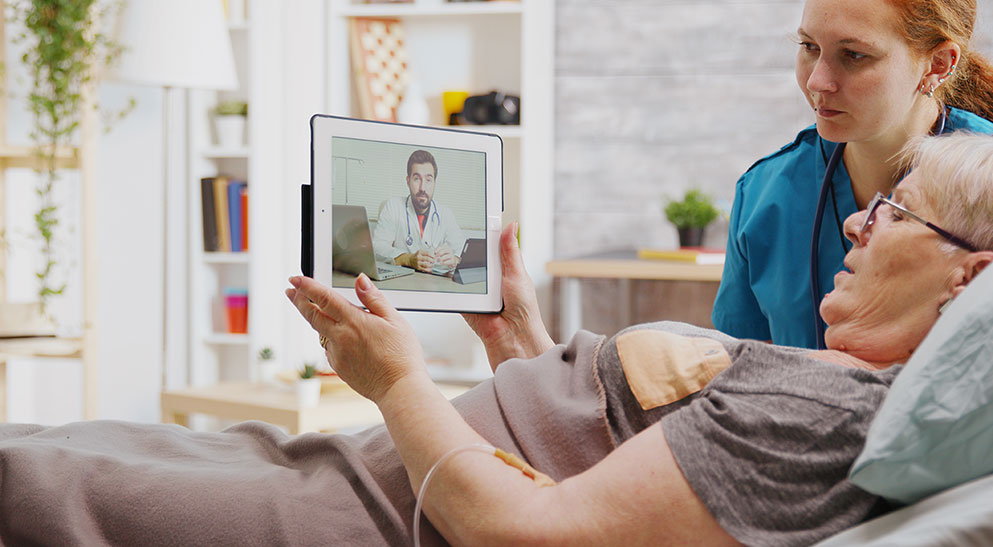The context of the pandemic has been conducive to the emergence of various initiatives to facilitate the delivery of care and services at a distance. Living environments such as public long-term care centres (CHSLDs) and private residences for the elderly (RPAs) have also followed suit to promote the well-being and facilitate the monitoring of their residents.
Deployment of digital tablets
One of the very first initiatives at the beginning of the pandemic was the deployment of nearly 1 000 tablets to help break the isolation of residents in more than 300 public CHSLDs. The use of this equipment not only allowed residents to communicate with their families and loved ones, but also to participate in social activities, physical activities, music therapy sessions and virtual masses. The involvement of the CHSLD staff, particularly the recreation officers and volunteers, has greatly facilitated participation in these activities. Following a survey conducted in the summer of 2020 with the care teams, it was reported that this use of the tablets was appreciated by the residents and their families.
Virtual consultations and interdisciplinary exchanges
Thanks to the multiple possibilities offered by telehealth, other avenues have been opened up to ensure continuity of care in a way that complements the basic service offer. For example, public CHSLDs have started to carry out teleconsultations and remote case discussions between the interdisciplinary team and families.
Dr. Julien Quinty, from the CHSLD Paul-Gilbert, reflects on his experience :
There are several clinical situations where telehealth can be useful.
For example, there is particular value in using video-consultation in wound assessment. When a nurse undoes the dressing, she can take pictures and share them in real or delayed time with the treating doctor or primary care nurse practitioner (PCNP), which greatly facilitates communication.
Similarly, in situations with terminally ill residents, the equipment has been used to validate the patient’s respiratory status and facial level. The advantage of being able to check and validate the patient’s condition remotely is that it saves a lot of time in some circumstances to make a change in treatment.
Contact Télésanté Application
Another initiative has also been launched to facilitate remote communication between professionals. This is the Contact Télésanté collaboration tool, which facilitates the sharing of clinical information in a secure manner for a list of patients being monitored jointly by the care team and the doctor. Its use is relevant in the context of medical on-call management, while being complementary to teleconsultation activities. The tool is currently being deployed in some of the province’s CHSLDs and several institutions have expressed an interest in receiving a detailed presentation with a view to integrating it in the near future.
Symptom Surveillance
Finally, another service that has emerged is called Vigie des symptômes (Symptom Surveillance). This is a modality for remote monitoring and follow-up of the evolution of COVID-19 symptoms. The project initially started in RPAs and continued in CHSLDs. Three CHSLDs took part in piloting the plateform: CHSLD Blainville (CISSS des Laurentides), CHSLD Saint-Rémi (CISSS de la Montérégie-Ouest) and Centre Cloutier-du-Rivage (CIUSSS de la Mauricie-Centre-du-Québec). Among the advantages identified when using this modality, we note the improvement in the quality and safety of care and services offered to residents, particularly due to the speed of information transmission as well as the shared availability of information by members of the care team. It was also noted that this allowed for a more collaborative and participatory approach. For example, caretakers reported an increased sense of involvement in the care trajectory of certain residents. With regard to the future use of this tool beyond the pandemic period, an openness was expressed to the idea that Vigie des symptômes could be used to monitor symptoms related to other health situations such as seasonal flu, summer heat waves or cases patient’s deconditioning state.
These initiatives are the first steps in a new era of virtual care in long-term care facilities. The Réseau québécois de la téléanté will continue to support the network’s institutions in their desire to implement innovative service modalities for the benefit of users and care teams in RPAs and CHSLDs.
